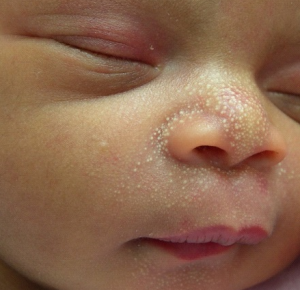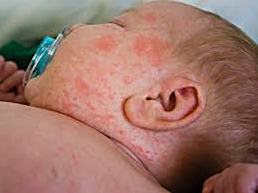
RASHES IN BABIES
As an anxious parent most of the times even a single blister or some rashes on the baby’s body is more than enough to make a parent tensed. Googling about rashes at that point will further make you end up with more confusions. So, here we are trying to address common queries related to the rashes in a practical way with pictures. It’s quite common for babies to develop rashes on the face or body from as early as a few days old, as their skin is very sensitive and it has to get adapted to a new environment. Not only that, the body has to adjust to the external temperature which is also different from what they had inside the womb and the atmosphere too is polluted. The babies may have rashes come and go away till they are 5 to 6 months. Most rashes are harmless and go away on their own. Some of the common rashes seen in babies are

Milia: Also knownas milk spot is the clogged sweat gland. They appear as very small, raised, pearly-white or yellowish bumps on the skin. They are seen frequently on the skin around the cheeks, nose, eyes and eyelids, forehead and chest. However, they can occur anywhere on the body. Milia are very common in newborn babies but can affect people of any age. In babies, it will clear by itself in a few weeks or months and no treatment is needed.
Baby Acne: Like acne in adults, baby acne are also red bumps or pimples. White pus-filled bumps called pustules or whiteheads may also develop and reddish skin may surround the bumps. Acnes are most commonly seen on the cheeks though it can develop anywhere on the face and even on the back. They seem to get pronounced when the baby cries a lot or there is any irritation to the affected area. Baby acne may be present at birth. In most cases, however, it will develop within two to four weeks after birth. It may last for a few days or a few weeks, though in some cases it may be present even for several months. It also doesn’t require much of a treatment and will go by itself
Cradle Cap: It is a kind of seborrheic dermatitis on the scalp where you can see flaky, dry skin that looks like dandruff, or thick, oily, yellowish or brown scaling or crusting patches. It is known as infantile seborrheic dermatitis and it’s very common. It is not because of any unhygienic conditions and experts opine that it can be due to over stimulated seborrheic gland or some yeast infestation that grow in the sebum. This will also go on its own, but daily mild gentle massage with lukewarm natural oil will help to relieve the itching also if present.
Diaper Rash: Diaper rashes are always a concern for the parents but are avoidable with proper care. The diaper area looks red, puffy and rashes may be present. Diaper rash can be mild with a few prickly red spots in a small area around the butt cheeks or they can be extensive which can spread up to baby’s thighs. The best way to keep this problem away is to properly clean and dry the genital area and the buttock area, changing of diapers at proper intervals and lastly to apply good diaper cream before every nappy change. Causes of diaper rashes are mainly wet bottom, sensitivity to certain chemicals used in napkins and wipes, bacterial or yeast infection due to soiled diapers, change in diet and use of certain antibiotics which causes heat in the body.
Measles: Measles is a highly contagious infection caused by the measles virus. Initial signs and symptoms typically include fever, often greater than 40 °C (104.0 °F), cough, runny nose and inflamed eyes. Two or three days after the start of the symptoms, small white spots may form inside the mouth known as Koplik spots. A red, flat rash usually starts on the face and then spreads to the rest of the body and typically begins three to five days after the start of symptoms. Symptoms usually develop 10 to 12 days after the exposure to an infected person and lasts 7 to 10 days. Complications occur in about 30% and may include diarrhea, blindness, inflammation of the brain, and pneumonia among others. Measles vaccine is very effective at preventing measles. The vaccine can be given by itself or in combination with other vaccines.
Drooling Rashes: Due to too much saliva, a drool rash may appear around the baby’s cheeks, mouth and fold of the neck or chest. They are typically flat or very slightly raised small red patches. Wiping the wet area can prevent or lesson it.
Eczema: Alternatively called atopic dermatitis is a type of skin rash that usually appears in the early age. Usually it is seen on the cheeks and scalp, but may spread to the arms, legs, chest etc. Etiology is idiopathic and no one is sure about the causative factors, but your child is more likely to have it if there is a family history of eczema or other allergies. It is not an allergic reaction but allergens like pollen grains, dust etc. can trigger it. A change in diet can also aggravate the condition sometimes. It can also get aggravated by contact with irritants and chemicals like soap, lotions, detergents etc.
Impetigo: Impetigo is a common skin infection in children. It is a bacterial infection and is contagious. It can be spread to others through close contact or by sharing towels, sheets, clothing, toys, or other items. Scratching can also spread the sores to other parts of the body
Erythema toxicum: Also known as Urticaria neonatorum is a benign, self-limited, asymptomatic skin condition that only occurs during the neonatal period. Small, erythematous papules, vesicles and occasionally pustules are seen on the body. The lesions disappear by itself without any medication.
Most of the rashes are not harmful or not associated with any complications. But if they are accompanied or associated with fever, vomiting, excessive crankiness, diarrhea etc. compulsorily visit a pediatrician.
Homeopathic Solutions for the above Skin ailments:
Generally it is instructed that Infants and babies up to the age of 1 year are avoided any medications in any skin complaints unless required. Apart from those complaints where the inner pathology is a reflection of skin complaints.
Ailments like Dermatitis, Eczema, Measles & Acne if required need to be treated but on the advice of a qualified pediatrician, dermatologist or any Homeopathic doctor.
Following Medications can be administered under supervision:
Note:
All Homeopathic Medications & Dilutions prescribed must be in very low quantities
Birth history and any other past history of the child must be taken into consideration before prescribing any medicine
Petroleum: Indicated for eczema where the skin becomes dry, rough, thickened and cracked. There is intense itching and the complaints are mostly worse in winter.
Caladium: Caladium is to be given to patients of an itching rash that alternately appears.
Belladona: It is very helpful in case of eruptions like scarlatina which spread suddenly.
Astacus Fluv: It is a great homeopathic remedy for a rash and itching all over the body.
Sarsaprilla: It works well for a rash that results from exposure to open air and causes dry itching.
Antim Crud: Acne with gastric derangements & white-coated tongue.
Berberis Aquifolium: When skin is rough with persistent acne.
Graphites: Intense itching with eruptions, moist or dry.
Hepar Sulph: Intense itching of the affected parts, deep cracks on the skin, patient is sensitive to touch and also to cold air but is better in the damp weather.
Mezereum: Best Homeopathic Medicine for crusts with intolerable itching and child feels worse in the bed & better in open air.
Tips for healthy skin:
- Maintain proper hygiene around the baby.
- Healthy diet for the moms while baby is exclusively breastfeeding and watch the babies diet after 6 months and his allergic reaction to any particular food on introducing solids.
- No exposure or proper care during excessive hot or cold weather.
- Keep separate soap and towel for the baby.
- Massage with medicated oils like lakshadi taila, nalpamaradi taila etc. or with natural oils like olive oil, cold pressed virgin coconut oil etc.
- Yellow moong dal powder can be used as a scrub during bathing.
- If the rashes appear you can use fresh Alovera gel for external application. It has a cooling and soothing effect and helps to reduce itching too if any.
- Sandalwood paste or organic turmeric powder, neem leaf juice etc. can also be used depending on the condition.
- Histocalamine or plain calamine lotion always help to reduce itching in case of most of the rashes.
- Always try to keep the skin moisturized. Moisturizers should be applied immediately after the bath, before the skin dries out.






